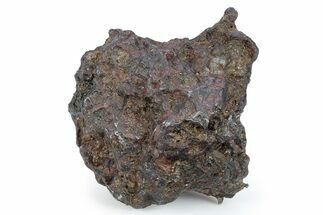1.27" Brahin Pallasite Meteorite (9.44 g) Slice - Belarus
This 1.27 wide (9.44 gram) slice of the beautiful Brahin pallasite meteorite. It mostly is one big olivine crystal and a little bit of the nickel-iron matrix. It comes with a small floating frame display case.
About The Brahin Pallasite
This stunning main group pallasite was first discovered near a village in the southeastern district of Brahin in Byelorussia (now Belarus) in 1807. Pieces were found over a 15-kilometer strewn field crossing the Dnieper River. At the time, it was only the second meteorite ever found on Soviet soil.
More pieces were recovered in 1968, and the pallasite was officially named Brahin (also Bragin). Over 800 kilograms of the meteorite have officially been recorded, but this is only an estimate: over 1,000 kilograms of material could exist, since the meteorite is a very popular specimen among collectors.
This stunning main group pallasite was first discovered near a village in the southeastern district of Brahin in Byelorussia (now Belarus) in 1807. Pieces were found over a 15-kilometer strewn field crossing the Dnieper River. At the time, it was only the second meteorite ever found on Soviet soil.
More pieces were recovered in 1968, and the pallasite was officially named Brahin (also Bragin). Over 800 kilograms of the meteorite have officially been recorded, but this is only an estimate: over 1,000 kilograms of material could exist, since the meteorite is a very popular specimen among collectors.
About Pallasites
Pallasite meteorites are a class of stony-iron meteorites. They were once believed to have originated at the core-mantle boundary of asteroids that shattered through impacts, but a recent hypothesis is that they are a mixture of core and mantle minerals.
Pallasite meteorites consist of olivine (peridot) crystals surrounded by iron-nickel matrix. Upon acid etching, some pallasites display interweaving structures known as Widmanstätten patterns (or Thomson lines) in the metallic matrix. These structures are iron-nickel alloy crystals, typically kamacite and taenite, that cooled over millions of years in the vacuum of space.
Pallasites are quite rare: only about 200 are known, and only four have had observed falls. This represents less than 0.2% of all classified meteorites!
Pallasite Care
Pallasites are even more susceptible than most iron meteorites to rusting and deterioration due to moisture in the atmosphere; proper care includes keeping them in moisture-free environments. This is particularly important in areas with high humidity, such as Florida. All pallasite material we sell has been stabilized in some way, which will help with this issue, but care still needs to be taken to keep your treasure in good condition. Keep pallasites stored in a moisture-free environment, preferably with a corrosion inhibitor such as silica gel beads or a dehumidifier.
Pallasite meteorites are a class of stony-iron meteorites. They were once believed to have originated at the core-mantle boundary of asteroids that shattered through impacts, but a recent hypothesis is that they are a mixture of core and mantle minerals.
Pallasite meteorites consist of olivine (peridot) crystals surrounded by iron-nickel matrix. Upon acid etching, some pallasites display interweaving structures known as Widmanstätten patterns (or Thomson lines) in the metallic matrix. These structures are iron-nickel alloy crystals, typically kamacite and taenite, that cooled over millions of years in the vacuum of space.
Pallasites are quite rare: only about 200 are known, and only four have had observed falls. This represents less than 0.2% of all classified meteorites!
Pallasite Care
Pallasites are even more susceptible than most iron meteorites to rusting and deterioration due to moisture in the atmosphere; proper care includes keeping them in moisture-free environments. This is particularly important in areas with high humidity, such as Florida. All pallasite material we sell has been stabilized in some way, which will help with this issue, but care still needs to be taken to keep your treasure in good condition. Keep pallasites stored in a moisture-free environment, preferably with a corrosion inhibitor such as silica gel beads or a dehumidifier.
$125
TYPE
Pallasite (PMG)
AGE
LOCATION
Southeastern Belarus
SIZE
1.27 x 1.1", 0.11" thick, 9.44 g
CATEGORY
SUB CATEGORY
ITEM
#307383
 Reviews
Reviews









